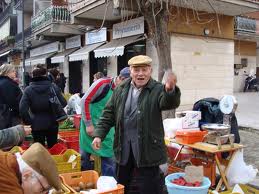SARONNO, Italy - There are many things to love about the island of Procida, starting with its location in the Gulf of Naples. Then there’s the lushness of the gardens, the palm trees, the creeping Bougainvillea, the fragrant lemon and orange groves, the colorful pastel houses, and the adorable three-wheel microtaxis that haul the weary up and down the steep road to the Santa Maria delle Grazie church. But most of all you have to love the people who live there, the ones who voted to restrict tourism and keep their town a real town and not just another tourist attraction.
 |
| Welcome to Procida |
That intelligent, forward thinking is the reason why there are only a few small hotels on the island, and even fewer private accommodations. Tourism was inevitable, as it usually is when a place is as beautiful as Procida, so it serves the local population well that most of the restaurants are centered down around the harbor. If the island looks familiar it may be because you've seen it before in “Il Postino” and “The Talented Mr Ripley”, as both were filmed here.
Procida is the smallest of the three islands in the Gulf of Naples, but one of the first to be inhabited, starting way back at some point between the 17th and 16th century BC. The Romans didn’t arrive until many centuries later. In the 6th century AD the island was annexed to the territory of Naples and it has been a part of Naples ever since.
 |
| Easter Procession |
On Good Friday there is a solemn procession, where a wooden statue of the dead Christ is carried on the backs of the faithful up to the highest point of Procida. The following morning, another procession of crosses and relics, accompanied by the sad music of trumpets, weaves through the streets. This is a procession of mourning in the ancient tradition of the Spanish Misteri, a tradition brought to the island when the Arogonese ruled in the 14th century.
The island has a rather turbulent history of repeated Saracen raids and marauding pirates, but that didn’t stop the Benedictine monks from building the abbey of San Michele Arcangelo. A hundred years later, In the 12th century, the island became a fiefdom of the Normans and the feudal lords of the island were the ‘da Prodidas,” including the famous Giovanna da Procida, one of the heroes of the Sicilian vespers. He was the first, great “signore” of the island, which now bears his name.
 |
| Fishing Boats of Procida |
OK, that's enough talk about the island, now it’s time to eat. This week’s recipe are two rather well known dishes, Meatballs and Spaghetti with Clams, but with a Procian twist – the addition of a little lemon juice from the lemons grown in the glorious lemon groves on the island.
 |
| With These Hands |
SPAGHETTI WITH CLAMS AND LEMON
Serves 4
320 g of spaghetti
1,2 kg of small clams
2 Amalfi Coast lemons (the juice of)
1 clove of garlic
1 small – and hot – red pepper (or crushed red pepper)
1 tablespoon of chopped parsely
1 dl (about ¼ cup) of extra virgin olive oil
salt
Heat the olive oil in a large frying pan, and when it is hot, but not boiling, brown the clove of garlic. Clean the clams carefully, under running water, eliminating those that don’t open
Put the clean clams in the frying pan, first removing the garlic clove. Cover the pan let cook over a low heat.
When the clams open, remove them from the pan and strain the cooking liquid.
Carefully wash the lemons, and with a vegetable peeler take off a very thin slice of the peel, taking care to leave the bitter white part. Finely dice the lemon peel and set aside. Squeeze the juice from the two lemons and strain the juice.
Return the clams, the strained cooking liquid and the lemon juice to the frying pan, along with the crushed red pepper, the diced lemon peel and reheat everything together over a low heat.
Bring a good amount of water to boil in a large pot, add salt and the spaghetti. When the spaghetti is cooked al dente, drain it and add to the clams and sauce in the frying pan. Turn the heat up and mix the spaghetti and clams, and add the chopped parsley. Serve in a large dish, sprinkled with some of the chopped lemon peel.
 |
| The Yellow Gold of the Amalfi Coast |
LEMON MEATBALLS
Ingredients: ground beef gr. 400, gr grated Parmesan. 50, 1 egg, 1 garlic clove, 1 tablespoon finely chopped parsley, flour, juice of 1 lemon, olive oil, salt and pepper.In a bowl mix the meat with the egg, cheese, parsley, finely chopped garlic, salt and pepper and let stand at least an hour. Then form the meatballs, (it helps if you wet your hands), and then roll them in flour, shaking off the excess.
Next, put them in a pan with 3-4 tablespoons of olive oil and cook over low heat for about half an hour turning frequently. After a half an hour, drizzle them with the lemon juice, raise the heat and as soon as the sauce starts to boil, remove pan from heat and serve them, piping hot with a side of sautéed spinach and mashed potatoes.





















